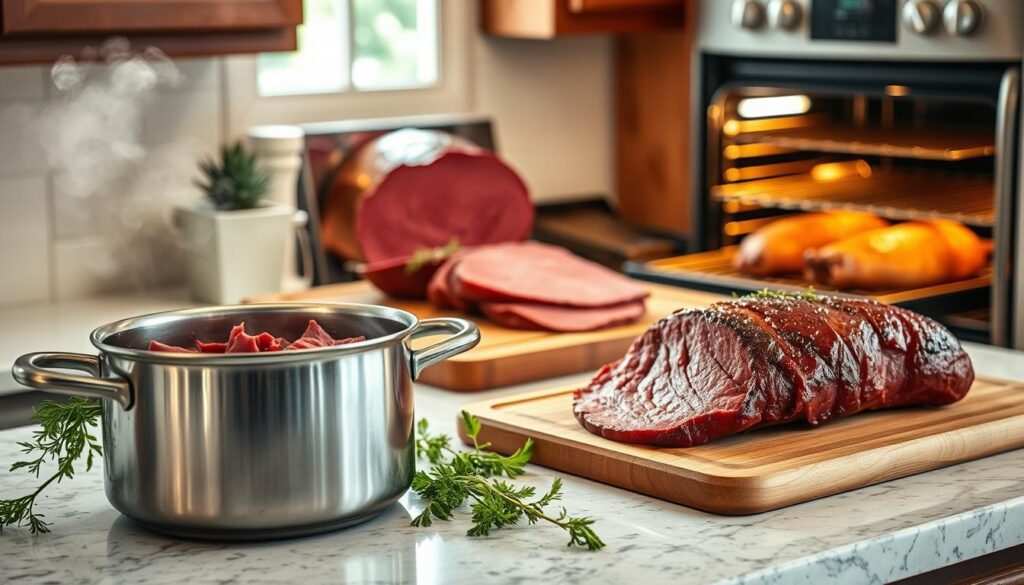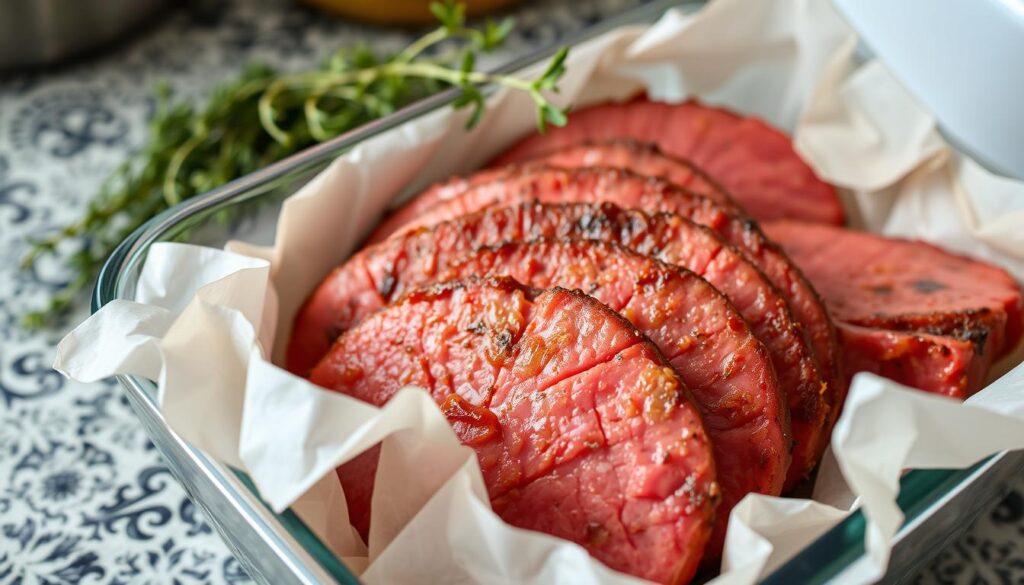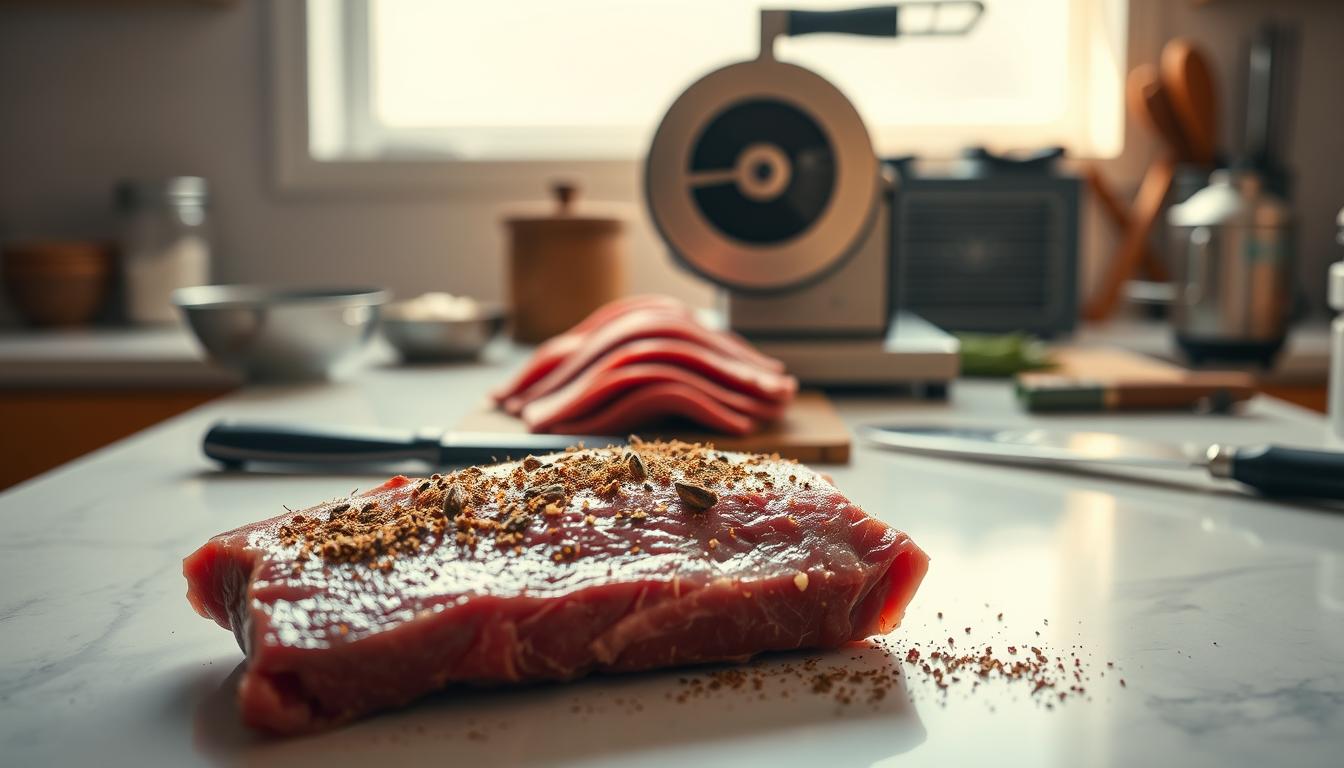Corned Beef Spices: How This Classic Meat Is Made from Start to Finish
Growing up in a traditional Irish-American household, I always loved the rich, savory aroma of corned beef simmering in the kitchen. It was more than just a dish; it was a family tradition passed down through generations. Making corned beef is a process that turns tough meat into tender, flavorful food.
Exploring corned beef reveals it’s more than a St. Patrick’s Day tradition. It starts with choosing the right brisket and preparing a special spice blend. This blend adds incredible depth and character to the meat. Learning about corned beef shows the detailed techniques that make it a favorite in American cuisine.
From picking the right brisket to using a special spice blend, each step is important. It makes corned beef unique in flavor and texture. Whether you cook at home or love food, knowing how corned beef is made will deepen your appreciation for it.
Table of Contents
Understanding Corned Beef: Origins and Basics
Corned beef is a dish that turns simple meat into a tasty treat. It’s made through a special preservation and flavoring method. This method has won the hearts of many food lovers for years.
What Makes Beef “Corned”
The term “corned” might seem odd, but it’s interesting. It doesn’t mean the meat is made with corn. Instead, it comes from the big salt grains used in the curing process.
- Salt grains were historically as large as corn kernels
- The curing process involves submerging beef in a specialized salt solution
- Corned beef seasoning plays a crucial role in developing its distinctive flavor
Why Brisket is the Preferred Cut
Brisket is the top choice for corned beef. It’s a tough cut from the cow’s lower chest. But, the brining process makes it tender.
| Brisket Characteristics | Corning Benefits |
|---|---|
| High connective tissue content | Breaks down during long cooking |
| Dense muscle structure | Absorbs brine curing mix effectively |
| Substantial fat marbling | Ensures rich, moist final product |
Historical Significance and Modern Uses
Corned beef started as a way to preserve meat. It became a favorite in the United States, thanks to Irish immigrants. Now, it’s a big part of St. Patrick’s Day celebrations.
Today, corned beef is used in many dishes. It’s in sandwiches, breakfast items, and more. The special seasoning makes it a hit with food fans.
Essential Equipment and Ingredients for Corned Beef
To make homemade corned beef, you need the right tools and ingredients. The quality of your tools and ingredients will make your dish taste great and authentic.
First, you’ll need some key equipment for corning. A big, non-reactive container is essential for brining. It can be glass, ceramic, or stainless steel. This keeps your meat’s flavor safe from unwanted chemical reactions.
Essential Equipment
- Large non-reactive brining container
- Dutch oven or large cooking pot
- Meat thermometer
- Sharp knife for trimming
- Measuring cups and spoons
The ingredients you choose are also crucial. Prague powder, a curing salt substitute, is key. It gives your corned beef its pink color and keeps it safe from bacteria.
Key Ingredients
- Beef brisket (4-5 pounds)
- Kosher salt
- Brown sugar
- Prague powder or curing salt substitute
- Pickling spices
- Fresh garlic
“The secret to great corned beef lies in the quality of your ingredients and the precision of your curing process.”
Choosing top-notch ingredients is vital for rich flavors. Your pickling spice mix should have mustard seeds, peppercorns, bay leaves, and other spices. These will add depth to your meat during brining.
| Equipment Category | Recommended Items |
|---|---|
| Brining | Glass or stainless steel container |
| Cooking | Large Dutch oven or heavy-bottomed pot |
| Measuring | Precise kitchen scale and thermometer |
By picking the best equipment and ingredients, you’re on your way to making delicious homemade corned beef. It will be as good as any you find in a deli.
The Brining Process: Foundation of Flavor
The brining process turns an ordinary beef brisket into a delicious corned beef. This step adds deep flavors, makes the meat tender, and keeps its special qualities.
Starting your brining journey means knowing the right mix of ingredients. The perfect blend of salt, spices, and pink curing salt is key. It decides the taste and quality of your corned beef.
Creating the Perfect Brine Solution
A great brine solution needs the right ingredients and careful mixing. Here’s what you’ll need:
- Filtered water
- Kosher salt
- Brown sugar
- Whole peppercorns
- Bay leaves
- Garlic cloves
The Critical Role of Pink Curing Salt
Pink curing salt, or nitrite curing salt, is crucial for corned beef. It adds color and stops bacteria from growing. It also gives the meat its unique pink color.
“Pink curing salt is the secret weapon in creating authentic, restaurant-quality corned beef.” – Professional Chef
Optimal Brining Duration
The brining time varies with the brisket’s size. A good rule is to brine for 1 day for every 2 pounds of meat. This lets the flavors soak in and cures the beef right.
| Brisket Weight | Recommended Brining Time |
|---|---|
| 3-4 pounds | 5-6 days |
| 5-6 pounds | 7-8 days |
Remember, making perfect corned beef takes time. The longer you brine, the more flavorful and tender your meat will be.
Corned Beef Spices and Seasoning Blend
Making the perfect corned beef starts with the right spices. The pickling spice blend turns a simple brisket into a flavorful dish. Each spice adds to the rich taste that makes corned beef special.
Your homemade corned beef spices need a mix of aromatics and seasonings. The classic blend includes:
- Black peppercorns
- Mustard seeds
- Coriander seeds
- Allspice berries
- Whole cloves
- Bay leaves
- Red pepper flakes
By making your own corned beef spices, you can experiment and add your touch. Some people add extra spices to their blend for more flavor:
| Spice | Flavor Profile | Recommended Quantity |
|---|---|---|
| Juniper Berries | Adds pine-like sharpness | 1-2 teaspoons |
| Ginger | Brings warmth and slight heat | 1 teaspoon |
| Cardamom | Introduces subtle citrusy notes | 1/2 teaspoon |
Using fresh and whole spices will give your corned beef the best flavor. Toasting the spices before grinding releases their oils. This makes your seasoning blend even more intense.
Step-by-Step Preparation Method
Preparing corned beef needs care and focus. Your journey starts with picking the right brisket. Then, you’ll learn about curing and seasoning.
Trimming the Brisket
Begin by choosing a top-notch beef brisket. Aim for a cut with the right fat balance. Here’s how to do it:
- Check the brisket for too much fat
- Trim off excess fat with a sharp knife
- Keep about 1/4 inch of fat for taste
- Rinse the brisket in cold water
- Pat it dry with paper towels
Applying the Cure
Making the perfect corned beef seasoning is an art. Look into these curing salt alternatives:
| Curing Method | Key Characteristics | Flavor Profile |
|---|---|---|
| Traditional Pink Curing Salt | Nitrite-based | Classic corned beef taste |
| Kosher Salt Blend | Natural alternative | Milder, less processed |
| Sea Salt Mixture | Mineral-rich | Complex, subtle notes |
Monitoring the Curing Process
Curing needs patience and watchful eyes. Put the seasoned brisket in a container that won’t react with it. Make sure it’s fully covered with your chosen seasoning. Refrigerate and flip the meat every few days to spread the flavors evenly.
Pro tip: The curing time is usually 5-7 days. It depends on the brisket’s size and how strong you like the flavor.
Cooking Techniques and Methods

When cooking corned beef, picking the right method is key. It makes the dish tender and full of flavor. The cooking method you choose can really change how the dish turns out.
There are many ways to cook corned beef, each with its own benefits:
- Boiling: A classic way that makes the meat tender
- Oven-Braising: It brings out rich, deep flavors
- Slow Cooker: It cooks the meat slowly and evenly
- Pressure Cooking: It cooks the meat fast
Each method needs special care with timing and temperature. The best method for you depends on what you have in your kitchen and what you like.
| Cooking Method | Cooking Time | Temperature | Flavor Intensity |
|---|---|---|---|
| Boiling | 3-4 hours | 212°F | Mild |
| Oven-Braising | 3-4 hours | 325°F | Rich |
| Slow Cooker | 8-10 hours | Low (200°F) | Deep |
| Pressure Cooker | 60-90 minutes | High pressure | Concentrated |
“The secret to perfect corned beef lies not just in the brine curing mix, but in mastering your chosen cooking technique.” – Culinary Expert
Pro tip: To make your corned beef even tastier, add more spices while it’s cooking. Try different methods to find your favorite way to cook it. This will make your meal unforgettable.
Traditional Accompaniments and Serving Suggestions
Corned beef becomes a feast when paired with the right sides. Your seasoning and pickling spice blend are key to making meals that wow. They turn a simple dish into a memorable experience.
Classic side dishes make meals special and match corned beef’s rich taste. Here are some favorites that always hit the spot:
- Boiled cabbage with a touch of butter
- Roasted root vegetables seasoned with pickling spice blend
- Creamy mashed potatoes
- Hearty Irish soda bread
Classic Side Dish Combinations
Irish-American dishes often pair corned beef with simple, hearty sides. The goal is to balance the meat’s bold flavor with sides that offer contrasting textures and tastes. For example, roasted carrots seasoned with your corned beef seasoning add a sweet touch to the meat’s saltiness.
Modern Serving Innovations
Today’s chefs are putting a new spin on corned beef. They’re coming up with creative ways to serve it:
- Gourmet Reuben sandwiches with artisan bread
- Corned beef hash with poached eggs
- Fusion tacos featuring sliced corned beef
- Corned beef loaded nachos
Your creativity can turn this traditional dish into something exciting and new. It’s a chance to surprise and delight your guests.
Storage Tips and Leftover Ideas

Keeping your homemade corned beef fresh is key. The right storage methods can keep its flavors rich and enjoyable for longer.
Here’s how to store leftover corned beef:
- Refrigerate in an airtight container within 2 hours of cooking
- Store for up to 5 days in the refrigerator
- Use a curing salt alternative like sea salt to help preserve flavor
Freezing is great for longer storage. Wrap the corned beef tightly in freezer-safe packaging. Pro tip: Slice the meat before freezing for easier portioning.
Turn leftover corned beef into new dishes:
- Corned beef hash for breakfast
- Reuben sandwiches
- Chopped salad topping
- Savory breakfast skillet
To make refrigerated corned beef taste fresh again, quickly sear it in a hot skillet. This will bring back its rich flavor and texture.
Tip: Always reheat leftover corned beef to an internal temperature of 165°F to ensure food safety.
Conclusion
Making corned beef at home turns a simple task into a craft. You learn to pick the best brisket, mix the right spices, and brine it perfectly. This skill connects you to many home cooks through the years.
The secret to great corned beef is in the prep and quality ingredients. Nitrite curing salt keeps it safe and gives it that pink color. Your choice of spices and brining time affects its taste and texture.
Creating corned beef is not just about following a recipe. It’s about growing your cooking skills. Each time you make it, you get better at mixing spices and curing. Share your dishes and feel proud of your new skill.
As you keep cooking at home, corned beef is just the start. Keep learning and enjoying the journey of making meals from scratch. It’s a rewarding adventure.

